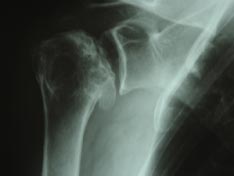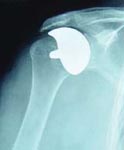|
Arthritis and
Shoulder Joint Replacement
Like arthritis of other joints, arthritis in the
shoulder leads to pain and stiffness.
Classically there is a significant reduction in
external rotation. The pain is felt deep within
the shoulder joint and can often disturb sleep.
Clinical examination may reveal crepitus
(grating noise) and pain on global movement.

There are three major
types of arthritis that can affect the
shoulder.
Primary
Osteoarthritis
Osteoarthritis, or "wear-and-tear" arthritis, is
a degenerative condition. The articular
cartilage that lines the joint surfaces gets
destroyed and the underlying bone rubs and
catches against its opposite surface.
Secondary
Arthritis
Secondary arthritis is a form of osteoarthritis
that develops after an injury, such as a
fracture or rotator cuff tear.
Rheumatoid
Arthritis
Rheumatoid arthritis is an inflammatory
condition of the joint lining. This inflamed
synovium can erode the articular cartilage and
bone away.
There have been significant advances in the
design of shoulder prosthesis. These range from
humeral head resurfacing to Reverse Geometry
Prostheses. The indications for joint
replacement have therefore also changed.
Any patient with significant shoulder pain,
either from Osteoarthritis, Inflammatory
arthritis (Rheumatoid) or even severe cuff
deficiency should be referred to a shoulder
specialist for consideration of joint
replacement.
In my practice I tailor the type of shoulder
replacement implanted to the patient,
considering the underlying cause o arthritis,
the demands the patient will likely put on the
new joint, the patient’s age and bone quality.
The vast majority of patients who have shoulder
replacement surgery need only stay in hospital
one night after their operation and may go home
the following day. Rehabilitative physiotherapy
varies according to which type of implant was
used.
Possible implants
1. Resurfacing Hemiarthroplasty
This procedure has a good record of achieving
significant reduction in pain symptoms for many
years, with low
complication rates. Only the ball of the
shoulder joint is replaced.

2.
Total Shoulder Replacement
In this operation, both sides of the shoulder
joint are replaced. It is a more technically
demanding operation than a hemiarthroplasty. The
pain relief provided is better than that
provided by hemiarthroplasty but unfortunately
the lifespan of the implant is probably less
than ten years. I therefore reserve this
procedure for those patients who have
significant erosion on the socket side of their
shoulder joint, or are older than 75years of
age.

3.
Extended Articular Surface Hemiarthroplasty
This procedure again only replaces the “ball”
side of the socket. It is used in patients who
have arthritis secondary to longstanding rotator
cuff tears if their deltoid muscle is
funcyioning well has a good record of achieving
significant
reduction in pain symptoms for many years, with
low complication rates. Only the ball of the
shoulder joint is replaced.

4.
Reverse Geometry Prosthesis
The operation is performed when patients have
arthritis causing significant pain and loss of
function as a result of a longstanding rotator
cuff repair.

Post-operative
Care
Following your surgery:.
- Your shoulder will be in a supportive sling to
allow the subscapularis tendin to heal. This
tendon is divided to allow access to the
shoulder joint and repaired at the end of
surgery.
- You will have an icepack to help reduce post
op inflammation. I recommend it is applied for
30-45 minutes and then removed for 2 hours
before being re-applied. This has been shown to
be effective for up to 72 hours post surgery.
- Sutures do not need to be removed. I routinely
use absorbable suture. Surgical dressings over
the wounds should not be removed for 2 weeks and
you should not get the dressing wet during this
period.
- Physiotherapy will follow a scheduled program
dependant upon the type of surgery that has been
performed.
- You will normally stay in hospital one night
post surgery and receive prophylactic
antibiotics .
- You will probably need regular analgesia for
several weeks to allow you to perform your home
exercise program.
Shoulder
Hemiarthroplasty
Outcome
All these procedures are very good at reducing
pain. Improvement in range of motion is less
predictable. The soft tissues that encapsulate
the shoulder often become contracted as part of
the arthritic process. Even with careful
surgical release, these chronically damaged
tissues may not function completely normally
afterwards.
Complications
Complications of shoulder joint replacement are
not common but can include
infection, deep venous thrombosis, dislocation,
fracture, nerve damage, post operative
stiffness, continued pain.
|







